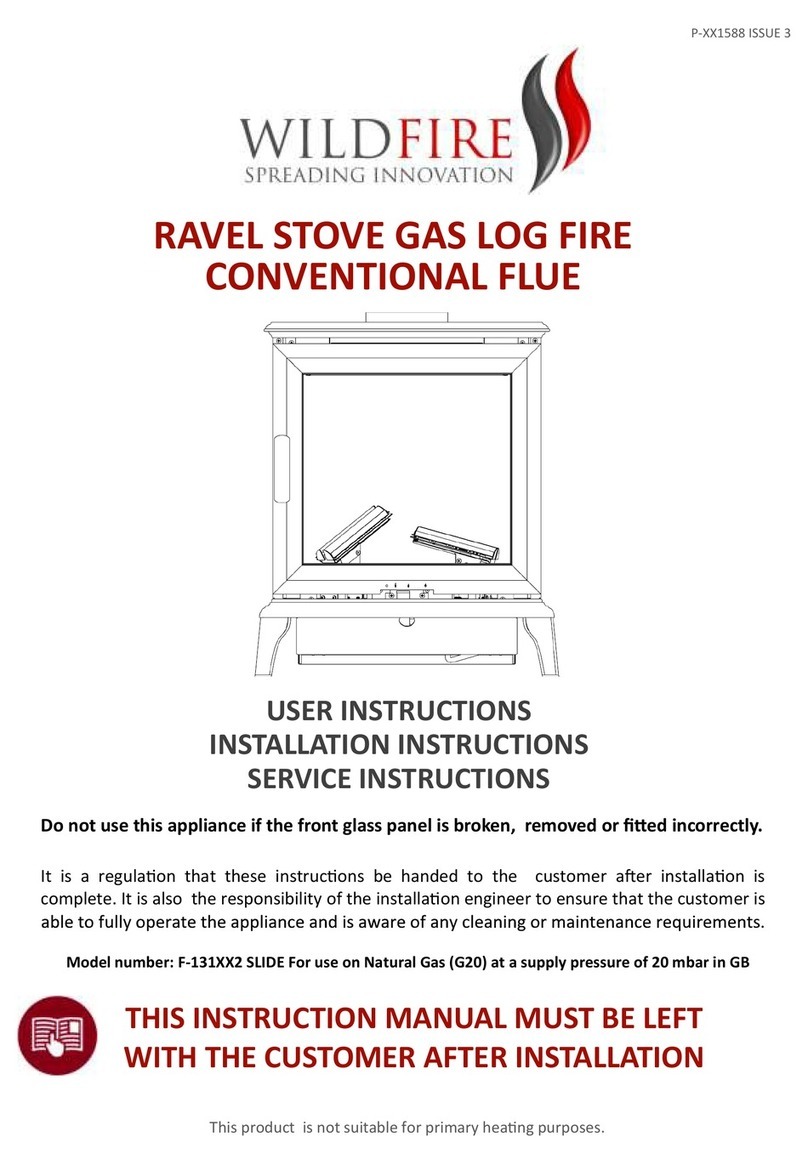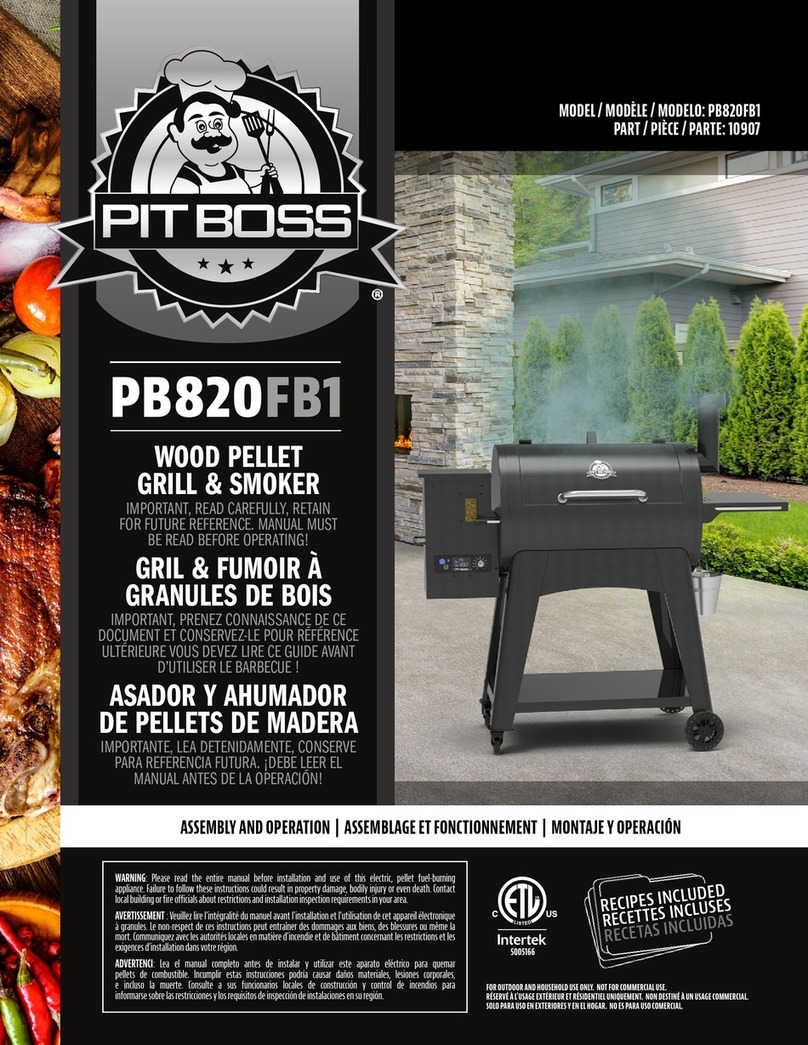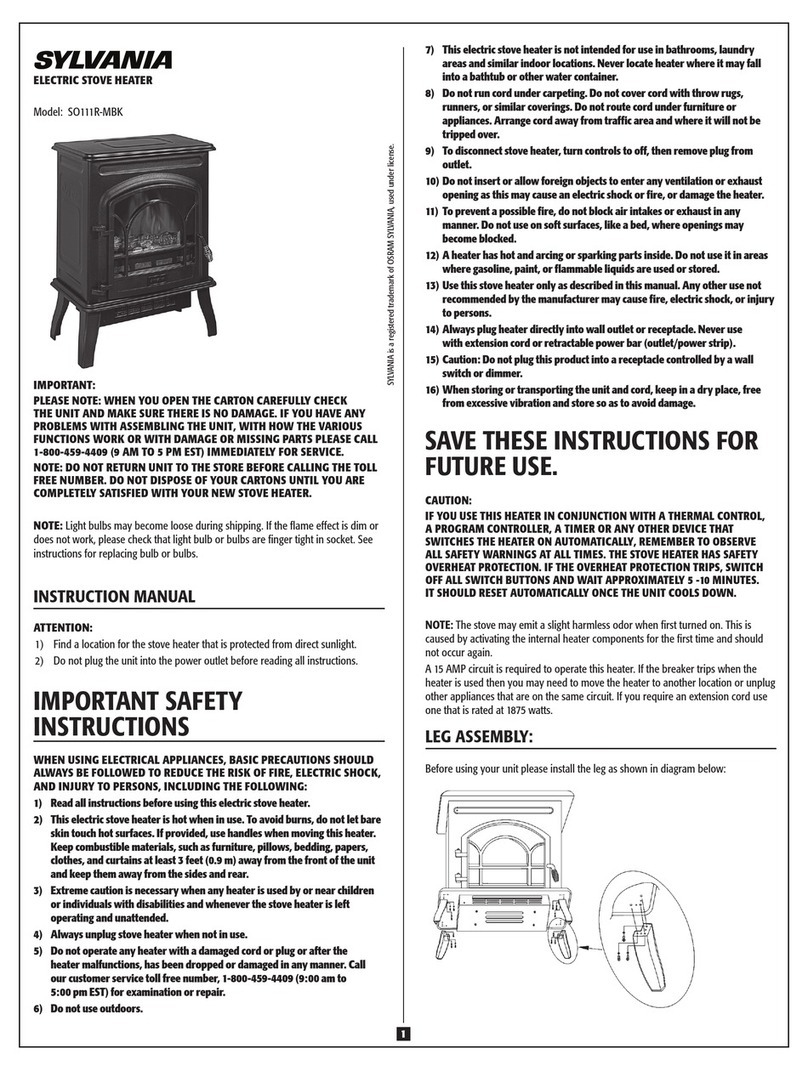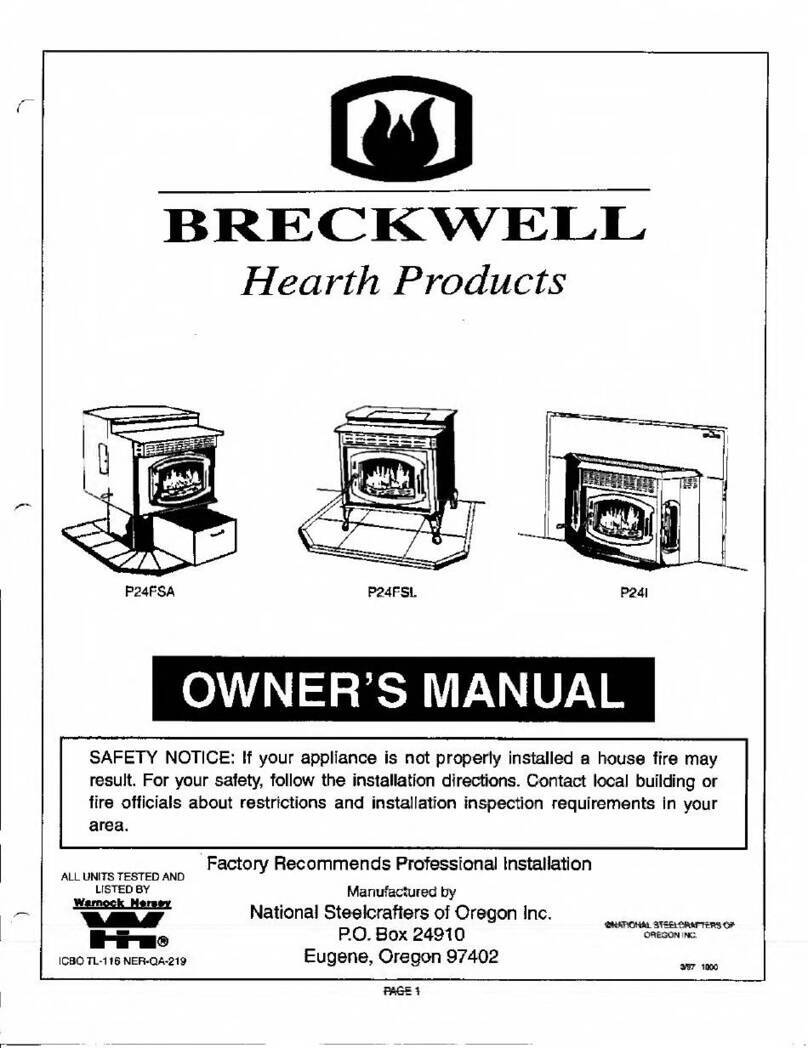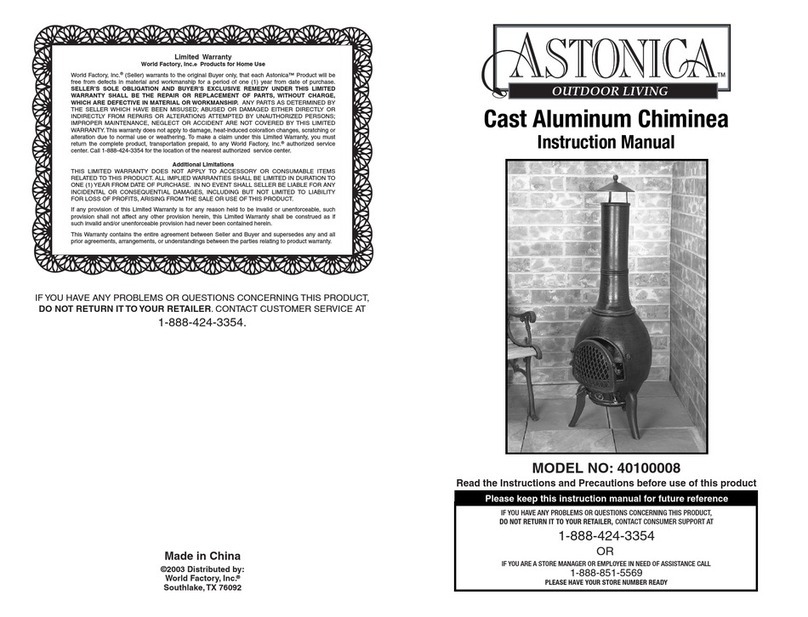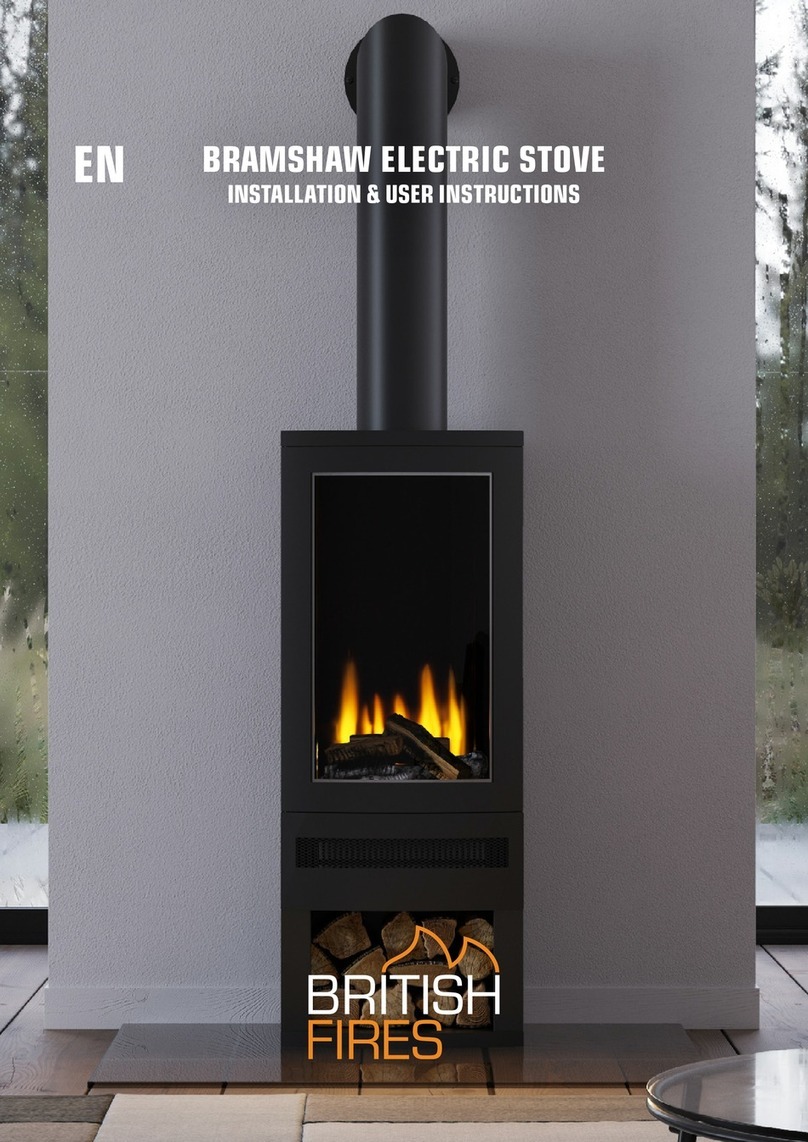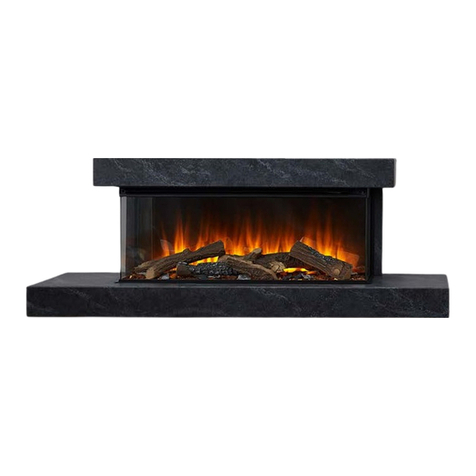
a fire risk exists if the heater is
covered or positioned incorrectly.
CAUTION: In order to avoid a
hazard due to inadvertent
resetting of the thermal cut-
out, this appliance must not be
supplied through an external
switching device, such as a
timer, or connected to a circuit
that is regularly switched on and
off by the utility.
WARNING: This heater is not
equipped with a device to control
the room temperature. Do not
use this heater in small rooms
when they are occupied by
persons not capable of leaving
the room on their own, unless
constant supervision is provided.
Keep furniture, pillows,
curtains and other fabric
materials away from appliance.
DO NOT leave the appliance
unattended during use.
DO NOT run the mains cable
under carpets, rugs etc.
DO NOT cover or obstruct
the heater in any way.
Overheating will result if it is
accidentally covered. Never
immerse the appliance in water
or any other liquids.
DO NOT use the appliance
outdoors.
Before cleaning the appliance,
ensure it is unplugged from the
power and that it is completely
cool. DO NOT clean the appliance
with abrasive chemicals.
Never use accessories that are
not recommended or supplied by
the manufacturer. It could cause
danger to the user or damage to
the appliance.
DO NOT insert or allow foreign
objects to enter the inlet or outlet
vents as this may result in electric
shock, fire or damage to the
appliance.
DO NOT install the fire using an
extension cord. Unplug from the
mains supply if the appliance is
not to be used for long periods.
DO NOT use this appliance in
an open flue.
This appliance is only suitable
for well-insulated spaces or
occasional use.
CAUTION: The user is cautioned
that changes or modifications
not expressly approved by the
party responsible for compliance
could void the user’s authority
to operate the equipment. This
device complies with Part 15
of the FCC Rules. Operation
is subject to the following two
conditions: (1) this device may not
cause harmful interference, and
(2) this device must accept any
interference received, including
interference that may cause
undesired operation.
NOTE: This equipment has been
tested and found to comply with
the limits for a Class B digital
device, pursuant to Part 15 of
the FCC Rules.
These limits are designed to
provide reasonable protection
against harmful interference in
a residential installation. This
equipment generates, uses and
can radiate radio frequency
energy and, if not installed
and used in accordance with
the instructions, may cause
harmful interference to radio
communications. However,
there is no guarantee that
interference will not occur in a
particular installation. If this
equipment does cause harmful
interference to radio or
television reception, which can
be determined by turning the
equipment off and on, the user
is encouraged to correct the
interference by one or more of
the following measures:
• Reorient or relocate the
receiving antenna.
• Increase the separation
between the equipment and
receiver.
• Connect the equipment into
an outlet on a circuit different
from that to which the
receiver is connected.
• Consult the dealer or an
experienced radio/TV
technician for help.
FCC RADIATION EXPOSURE STATEMENT:
This equipment complies with
FCC radiation exposure limits
set forth for an uncontrolled
environment.
This equipment should be
installed and operated with
a minimum distance of eight
inches between the radiator and
your body. This transmitter must
not be co-located or operating
in conjunction with any other
antenna or transmitter.
// 1.0 IMPORTANT NOTES
Important – these instructions should be read carefully and retained for future reference.
When using this electrical appliance, basic precautions should be followed to reduce the risk of fire, electric shock and injury to person, including the following
1) Read all instructions before
using this heater.
2) This heater is hot when in
use. To avoid burns, do not let
bare skin touch hot surface.
If provided, use handles when
moving this heater. Keep
combustible materials, such as
furniture, paper, and clothes at
least 3ft (0.9m) away from the
front heater
3) Extreme caution is necessary
when any heater is used by or
near children or invalids and
whenever the heater is left
operating and unattended.
4) Do not operate any heater
after it malfunctions. Disconnect
power at service panel and have
heater inspected by a reputable
electrician before reusing.
5) Do not use outdoors.
6) To disconnect heater, turn
controls to off, and turn off power
toheater circuit atmain disconnect
panel (or operate internal
disconnect switch if provided).
7) Do not insert or allow foreign
objects to enter any ventilation
or exhaust opening as this may
cause an electric shock or fire,or
damage the heater.
8) To prevent a possible fire, do
not block air intakes or exhaust
in any manner. Do not use on
soft surfaces, like a bed, where
openings may become blocked.
9) A heater has hot and arcing
or sparking parts inside. Do not
use it in areas where gasoline,
paint, or flammable liquids are
used or stored.
10) Use this heater only as
described in this manual. Any
other use not recommended by
the manufacturer may cause
fire, electric shock, or injury to
persons.
11) Heater includes an audible
or visual alarm to warn that
parts of the heater are
getting excessively hot. If the
alarm sounds (or illuminates),
immediately turn the heater off
and inspect for any objects on
or adjacent to the heater that
may have blocked the airflow
or otherwise caused high
temperatures to have occurred.
DO NOT OPERATE THE HEATER
WITH THE ALARM SOUNDING
OR ILLUMINATING.
12) SAVE THESE INSTRUCTIONS
This heater must be used on an
AC supply only and the voltage
marked on the heater’s rating
label must correspond to the
supply voltage.
DO NOT switch the appliance
on until it is properly installed as
described in this manual.
This appliance can be used by
children aged from 8 years and
above and persons with reduced
physical, sensory or mental
capabilities or lack of experience
and knowledge if they have been
given supervision or instruction
concerning use of the appliance
in a safe way and understand
the hazards involved. Children
shall not play with the appliance.
Cleaning and user maintenance
shall not be made by children
without supervision.
Children of less than 3 years
should be kept away unless
continuously supervised. Children
aged from 3 years and less than
8 years shall only switch on/
off the appliance provided that
it has been placed or installed in
its intended normal operating
position and they have been
given supervision or instruction
concerning use of the appliance
in a safe way and understand the
hazards involved.
Children aged from 3 years and
less than 8 years shall not plug in,
regulate and clean the appliance
or perform user maintenance
CAUTION: Some parts of this
appliance can become very hot
and cause burns. Particular
attention has to be given where
children and vulnerable people
are present.
Check that all parts included
are intact and not damaged.
If the supply cord is damaged,
it must be replaced by the
manufacturer, its service agent
or similarly qualified persons in
order to avoid a hazard. Never
use the appliance if the cord or
any part of the appliance shows
signs of damage. The heater
must not be located immediately
below a socket-outlet.
DO NOT use this heater in the
immediate surroundings of a bath,
a shower or a swimming pool.
WARNING: In order to avoid
overheating, do not cover the fan of
the heater.
DO NOT use this heater with
a programmer, timer, separate
remote-control system or any
other device that switches the
heater on automatically, since
// 02© 2020 British Fires

